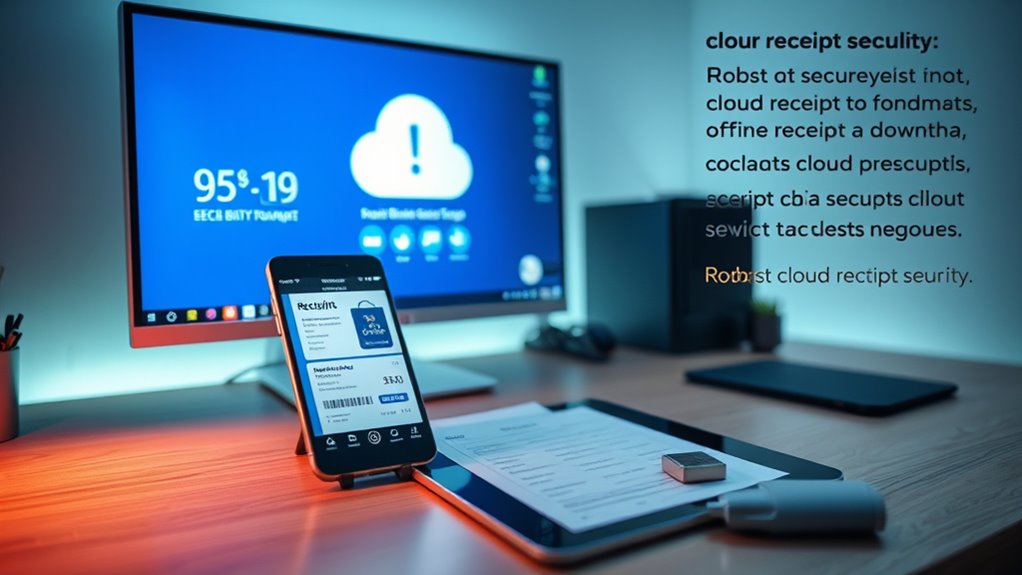To keep receipts in the cloud audit-proof, focus on secure, compliant storage by encrypting data, using strong access controls, and regularly backing up records. Organize receipts with clear, consistent naming and tagging, and group related files for easy retrieval. Choose cloud providers with certifications like ISO 27001 or SOC 2, and monitor access logs for traceability. Ensuring data integrity and legal compliance helps protect your records; learn more on how to implement these strategies effectively.
Key Takeaways
- Use encrypted cloud storage with certifications like ISO 27001 or SOC 2 for compliance and security assurance.
- Implement digital signatures and tamper-proof logs to verify receipt integrity and prevent unauthorized modifications.
- Organize receipts with consistent naming, tagging, and folder structures for easy retrieval and audit readiness.
- Regularly back up receipts using compliant media and maintain version control to ensure data availability and authenticity.
- Apply role-based access controls and multi-factor authentication to restrict unauthorized access and safeguard sensitive records.
Understanding Legal and Compliance Requirements for Digital Receipt Storage

Understanding the legal and compliance requirements for digital receipt storage is essential to guarantee your business remains audit-ready and adheres to regulations. To ensure record authenticity, your digital receipts must be securely stored and organized, maintaining their integrity throughout the retention period. A digital signature helps verify that the receipt has not been altered, reinforcing its authenticity for audits. You must protect electronic records against unauthorized access, modification, or deletion until their authorized disposition date. Regular backups using compliant media are crucial, and capturing metadata at the time of creation supports authenticity and usability. Keep in mind that IRS rules typically require retaining receipts for at least three years, extending to seven or more depending on specific circumstances, making compliance critical for your business’s financial integrity. Incorporating essential oils for record-keeping can enhance your workflow by promoting focus and reducing stress during audits.
Implementing Strong Cloud Security Measures to Protect Receipt Data

Securing receipt data stored in the cloud requires a thorough approach that combines multiple security measures. Implementing encryption protocols like SSL/TLS and AES ensures data remains protected during transit and at rest. Strong access controls, including role-based permissions and multi-factor authentication (MFA), restrict unauthorized access and add layered defenses. Regular audits help detect unusual activity and verify permissions, while monitoring access logs creates traceability. Here’s a quick overview:
| Security Measure | Description | Best Practice |
|---|---|---|
| Encryption Protocols | Protect data during transfer and storage | Use AES 256-bit encryption |
| Access Controls | Limit user permissions | Implement role-based access control (RBAC) |
| Multi-Factor Authentication | Add verification steps beyond passwords | Enforce MFA for all accounts |
| Regular Security Audits | Detect vulnerabilities and unauthorized access | Schedule periodic reviews |
| Monitoring & Logging | Track access attempts and changes | Maintain detailed logs for investigation |
Additionally, understanding cloud security best practices can further enhance the protection of sensitive receipt data. These steps help keep your receipt data safe and audit-proof.
Organizing and Managing Digital Receipts for Easy Access and Audit Readiness

Organizing and managing your digital receipts effectively guarantees quick access and prepares you for audits. To do this, focus on receipt categorization and digital tagging for efficient retrieval. Use consistent, descriptive file names that include key details like date, vendor, and amount, making searches straightforward. Group related receipts into folders by expense type, month, or project to reduce clutter. Merge related receipts into single PDFs for easier review, especially during tax time. Regularly update your folder structure and naming standards to keep everything clear as your collection grows. Additionally, leverage digital tagging to add searchable metadata to files, speeding up the retrieval process during audits. Implementing a regular review schedule can help maintain organization and prevent clutter, ensuring your system remains effective over time. These practices ensure your receipts are organized, accessible, and audit-ready at all times, and being aware of privacy policy considerations can help protect your data while managing your digital records.
Selecting the Right Cloud Storage Provider With Audit-Readiness Features

Choosing a cloud storage provider that supports audit-readiness features is essential for maintaining the integrity and accessibility of your digital receipts. Look for providers with strong Cloud Certification like ISO 27001, SOC 2, or GDPR, ensuring compliance with recognized standards. Verify they offer detailed audit reports and continuous updates to certifications, demonstrating commitment to security and compliance. Ensure log integrity through tamper-proof, centralized logs that capture all critical events—authentication, data access, and changes. Automation tools that assess compliance and collect audit evidence reduce manual effort and human error. Additionally, selecting providers with a proven track record in security standards and compliance management helps ensure your receipts are stored reliably and audit-ready.
Mitigating Risks and Ensuring Data Integrity in Cloud-Based Receipt Archiving

Mitigating risks and maintaining data integrity in cloud-based receipt archiving are critical steps to protect your business from cyber threats, data corruption, and compliance issues. To do this effectively, focus on securing your receipt format and storage location. Assure receipts are stored in standardized, legible formats and validated regularly. Protect your storage location with multi-factor authentication, strong encryption, and role-based access control. Be vigilant about data quality by conducting periodic validation and reconciliation to identify duplicates or missing receipts. Also, assess regulatory requirements, like IRS or SEC standards, to maintain compliance. Remember to implement extensive backup and versioning strategies, so you can recover quickly from data loss or corruption. Proper training and strict policies will further minimize human errors and strengthen your data integrity safeguards. Ensure data precision, consistency, reliability, and completeness through ongoing monitoring and adherence to best practices, which are essential for a robust cloud receipt management system. Additionally, leveraging automated validation tools can help streamline the process of maintaining data quality and integrity.
Frequently Asked Questions
How Can I Verify the Authenticity of Digital Receipts Stored in the Cloud?
To verify the authenticity of digital receipts stored in the cloud, you should check their digital signature to confirm the issuer’s identity and guarantee they haven’t been tampered with. Additionally, perform metadata verification to examine details like timestamps, issuing authority, and file integrity. This combined approach helps you confidently confirm that your digital receipts are genuine, unaltered, and securely stored for future reference.
What Are the Best Practices for Managing Multiple Cloud Storage Providers?
Managing multiple cloud providers is like juggling knives—without proper planning, it’s risky. You should focus on smart cloud provider selection and clear storage organization to keep everything running smoothly. Use multi-cloud management tools, automate routine tasks, and standardize security policies across platforms. Regularly monitor your resources to optimize cost and performance, and guarantee data portability. This way, you stay in control and avoid chaos amid the cloud chaos.
How Do I Handle Receipt Updates or Corrections in Digital Archives?
When handling receipt amendments, you should establish clear digital correction processes that track every update. Use version control systems to monitor changes, ensuring each receipt correction is logged with details like who made it and when. Secure your updates with strict access controls and encryption. Tag or separate amended receipts from originals to maintain clarity, and regularly review your records for consistency, supporting transparency and audit compliance.
What Are the Costs Associated With Maintaining Audit-Proof Cloud Storage?
Considering cloud costs can conjure concern. Storage costs climb with volume, while security fees secure your data but can markedly spike expenses. Longer retention amplifies costs, especially for audit-proof archives. Frequent access or retrieval inflates fees, and compliance features like encryption add to expenses. Tiered storage options can tame costs, but managing lifecycle and ensuring security requires strategic planning. Staying savvy ensures your storage stays secure, affordable, and audit-ready.
How Can Small Businesses Ensure Ongoing Compliance With Evolving Regulations?
To guarantee ongoing compliance, you need to stay on top of regulatory updates by regularly reviewing federal and state laws. Invest in staff training so your team understands current requirements, especially for reporting and recordkeeping. Establish internal controls and designate compliance officers to monitor changes. Using compliance tools and consulting experts can also help, but keeping your staff informed and adaptable is vital for meeting evolving regulations effectively.
Conclusion
By adopting secure cloud storage for your receipts, you guarantee easy access and compliance during audits. Did you know that 70% of organizations report improved audit readiness after switching to digital, cloud-based recordkeeping? Staying proactive with strong security, organized management, and choosing the right provider keeps your data safe and audit-proof. Embrace these tips, and you’ll confidently meet legal requirements while streamlining your receipt management process.









